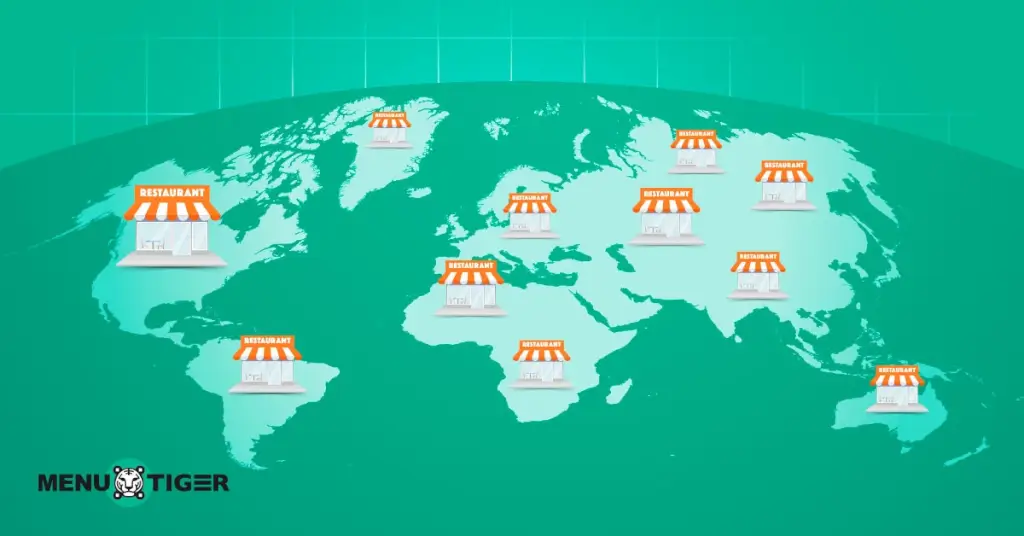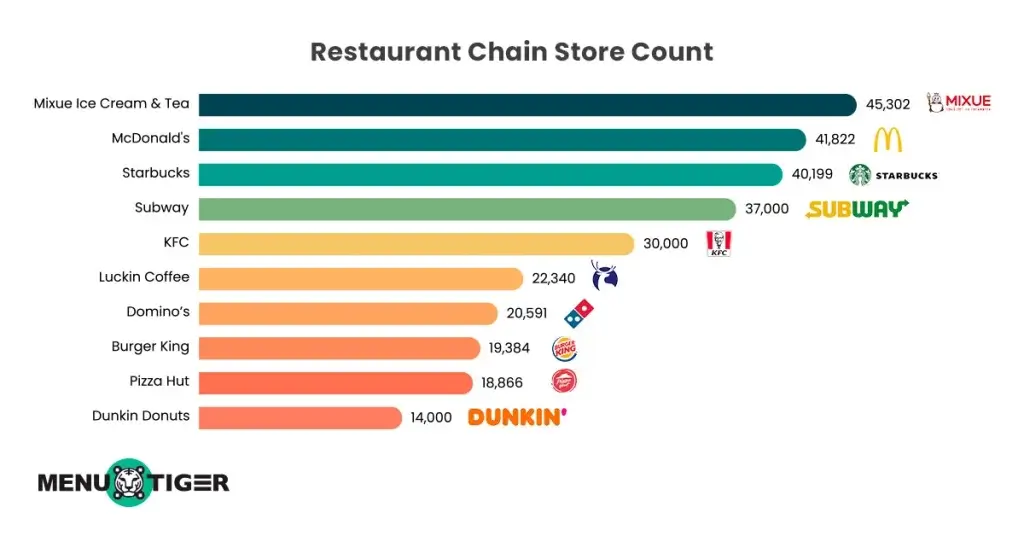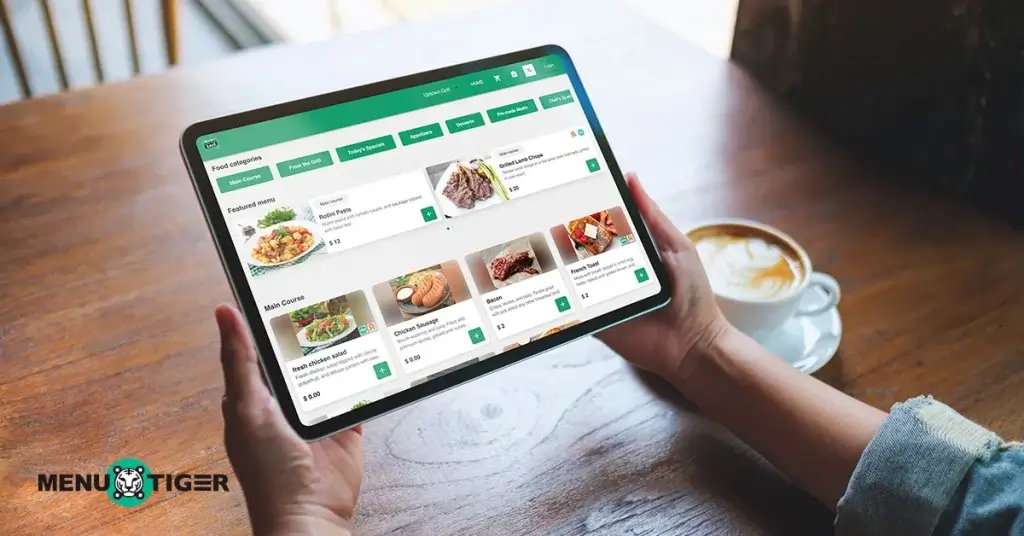
Restaurant Chain 101: Everything You Need to Know
Last Updated: November 10, 2025
According to Oysterlink, a specialized job platform, only 34.6% of restaurants make it past the 10-year mark. And scaling a single establishment into a full-fledged restaurant chain? Now that’s the ultimate taste of success.
However, no matter how big the success is, in business, learning is constant. You’ve mastered running a single restaurant, but scaling to a chain means there’s a whole new playbook to learn.
This progression is beyond expansion. You still need to adapt to modern tools like digital menus to ensure a consistent, seamless experience at every new location.
With so much at stake, it’s wise to approach this journey step-by-step, and the first step is to start learning about this whole chain.
What is a restaurant chain?
A chain of restaurants is when a brand grows to have at least a certain number of locations, all owned and operated under the same corporate ownership.
Think of McDonald's, one of the biggest fast-food chains in the world. According to DotSignage, a digital signage platform, McDonald's has over 41,822 outlets, spread across different countries. Despite the global presence, each outlet has brand consistency, a standardized menu, consistent restaurant technology experience, and ownership.
While fast food chains are commonly mentioned, the concept isn't limited to them. The idea of a chain isn't focused on a specific type of food business; It is fundamentally about a single brand that has successfully replicated its business across multiple locations.
Is the chain the same as franchises?

While the terms are often used interchangeably, a franchise is not the same as a chain. The heated argument about chain restaurant vs. franchise comes down to one fundamental difference: ownership.
According to the International Franchise Association, franchising is a way for a business to grow and deliver its products or services by granting licenses to independent operators.
Think of it this way: “chain” is the big, all-encompassing term. A chain is any group of multiple locations that share the same brand. A franchise is simply the business model that many chains use to expand.
A franchise restaurant is about who owns the location, while a chain is about having multiple locations under the same brand. A franchise can be part of a chain, but an individual franchise location does not make a chain.
Who started the first chain restaurant?
The “first chain” distinction is often debated, as sources cite different establishments for this title. Let’s break down their histories and determine who was truly first.
White Castle
White Castle was founded in 1921 in Wichita, Kansas, by cook Walter A. Anderson and businessman E.W. “Billy” Ingram. At the time, hamburgers were often seen as low-quality and even unsanitary street food. Their goal was not just to sell hamburgers, but to change the way people thought about them.
Background of expansion
According to America Comes Alive, an American history storytelling, after opening their first location in Wichita, White Castle quickly began to grow. By 1930, less than a decade later, they had expanded into 12 cities across the Midwest and even reached New York and New Jersey.
A&W
A&W was founded in 1919 by Roy W. Allen, who opened his first root beer stand in Lodi, California. He later partnered with Frank Wright, and they opened the first A&W restaurant in Sacramento, California, in 1923. The name “A&W” was derived from their initials, symbolizing their collaboration and shared vision.
Background of expansion
Researched by Culinary Depot, a food service equipment supplier, A&W started franchising its root beer stands and restaurants in 1925, making them one of the first and most successful franchise models in the food industry.
The Verdict
Determining the very first food service chain depends on how you define a “chain.” If the key factor is expansion across multiple locations, White Castle takes the lead, having established several company-owned restaurants under the same brand by 1930.
A&W, on the other hand, pioneered the franchise model starting in 1925, but the total number of independently operated locations at the time is unclear.
Since a small or unverified number of franchises does not necessarily qualify as a chain, A&W is recognized as the first franchise model rather than the first chain.

What is an example of a chain of restaurant?

Since you passed the start-up phase and are thinking of expanding, it's smart to look at the restaurant chain closing rate and the biggest players to see how they pulled it off.
According to 2025 data from DotSignage, a cloud-based digital signage platform, here are some of the world's largest food service brands ranked by number of locations.
1. Mixue Ice Cream & Tea
Affordable ice cream and bubble tea brand.
Store count: 45,302
2. McDonald's
Fast food for classic American hamburgers and meals.
Store count: 41,822
3. Starbucks
Coffeehouse chain serving specialty coffee and beverages.
Store count: 40,199
4. Subway
Quick-service sandwiches and salads.
Store count: 37,000
5. KFC
For fried chicken and fast-food meals.
Store count: over 30,000+
6. Luckin Coffee
Fast-growing Chinese coffeehouse brand
Store count: 22,340
7. Domino’s
Pizza delivery and takeout chain.
Store count: 20,591
8. Burger King
Global fast-food chain specializing in burgers.
Store count: 19,384
9. Pizza Hut
Pizza and casual dining chain.
Store count: 18,866
10. Dunkin Donuts
Coffee, donuts, and quick breakfast items.
Store count: 14,000
What is the biggest restaurant brand in the world?
As presented by DotSignage, Mixue Ice Cream & Tea is the largest chain in the world regarding store count. However, Starbucks holds the title of the biggest restaurant by revenue, reporting $36. 35 billion and a net income of $3.13 billion as of March 31, 2025. Starbucks also operates a global network of 40,200 stores, as reported by Investopedia, a leading finance education platform.
What is the biggest restaurant brand in the U.S.?
According to research by the New York Post, a daily newspaper and digital media company, Subway’s U.S. store count has declined to below 20,000 locations. However, despite this decrease, it still holds the top spot with 16,935 domestic stores, while McDonald’s ranks third with 13,559 locations in the country.
How to build a restaurant brand into a chain
It’s time to finally expand your restaurant branding to compete globally with the most popular foodservice brands. Without further ado, here’s what you should do to get started.
1. Start by building a concept
Danny Meyer, the founder of Union Square Hospitality Group, didn't set out to build a burger empire. Shake Shack started as a humble hot dog cart in Madison Square Park to support a public art project.
The demand was so overwhelming that it evolved into a permanent kiosk. The core concept wasn't just fast food; it was “fine casual,” a high-quality burger and shake experience in a beautiful, public space.
The success of the first location proved that the restaurant goals and concept were a winner before they ever considered expansion.
2. Build a scalable system
This is where the magic (and the hard work) happens. You need to document everything. The recipes, the kitchen workflow, order management, the employee training manual, and the supply chain logistics.
How do you ensure the fried chicken tastes the same in location two as it did in location one?
3. Fund your growth

Expanding a restaurant requires significant capital. You need to be prepared to secure funding through various avenues, such as investors, personal savings, bank loans, or partnerships.
This part can feel intimidating because you're not just asking for money; you are selling.
But think of Sweetgreen, a salad chain. It all started small, with three college friends raising capital through friends and family. As Sweetgreen became more popular and successful, it caught the attention of professional investors.
They were able to show investors their current revenue and their vision for becoming a national brand.
To boost visibility and generate extra revenue during expansion, consider using affiliate software.
It allows you to partner with influencers, bloggers, or food reviewers who can promote your brand and earn commissions on referred sales — all while helping you reach new customer bases efficiently.
You have to be able to tell your story, show your numbers, and prove that your concept is not only profitable but also scalable.
4. Build a winning team
A food service chain is only as strong as its people. You need to hire individuals who not only believe in your vision but are also empowered to execute it.
You can't be everywhere at once. Your managers are your ambassadors; your employees are the face of your brand.
You need to invest in training, create a positive culture, offer incentives, and even ensure restaurant safety that makes people want to stay and grow with the company.
5. Perfect the timing and location
You can begin to expand, but don't rush it. This is the most critical stage. One bad location can drain resources and tarnish your brand. You need to analyze demographics, foot traffic, and competition. Every new opening should be a strategic move, not a blind gamble.
6. Master digital menu for a uniform experience

Look for a digital menu that’s simple to update without going through too many steps. The best systems let you change items, prices, or daily specials in just a few clicks.
Some systems let you edit menus across different locations and update what guests see at each table. This way, your customers always get the right information and a consistent dining experience, wherever they visit.
7. Study the restaurant chain news
Don't just rely on gut feelings. In today's competitive landscape, your intuition must be backed by data.
Successful chains use technology to understand their customers on a granular level.
They track everything: what types of menu items are most popular, which locations have the highest foot traffic at different times of the day, and which marketing campaigns are driving the most sales.

You've got the knowledge. Now, it's time to expand!
Restaurant chain, at their core, are like a big, extended family. They're built on the idea of consistency, the comforting promise that no matter where you are, a familiar face (or flavor) is waiting for you.
This isn't just about food; it's about a feeling of home, a predictable and pleasant experience in an unpredictable world.
Behind the scenes, it's a bustling network of people: the chefs who perfect the recipes, the managers who keep the ship sailing smoothly, and the servers who greet you with a smile. It's a complex dance of menu management, where every item is carefully curated.
FAQs
Eulla
Eulla joined MENU TIGER’s Content Team with a foundation in English teaching. She combines language expertise and creativity to produce engaging content that educates audiences and drives meaningful results.


